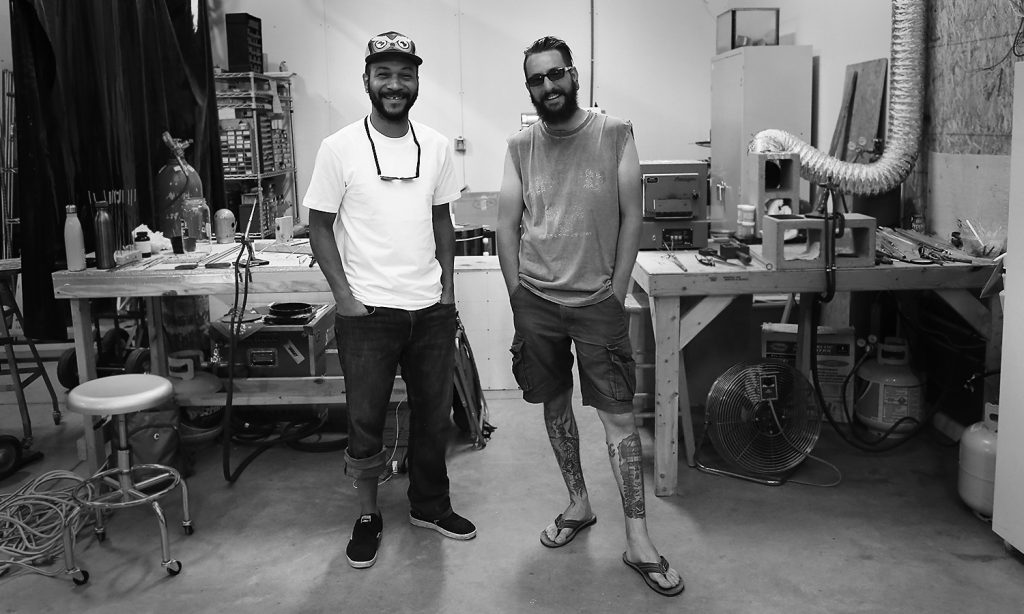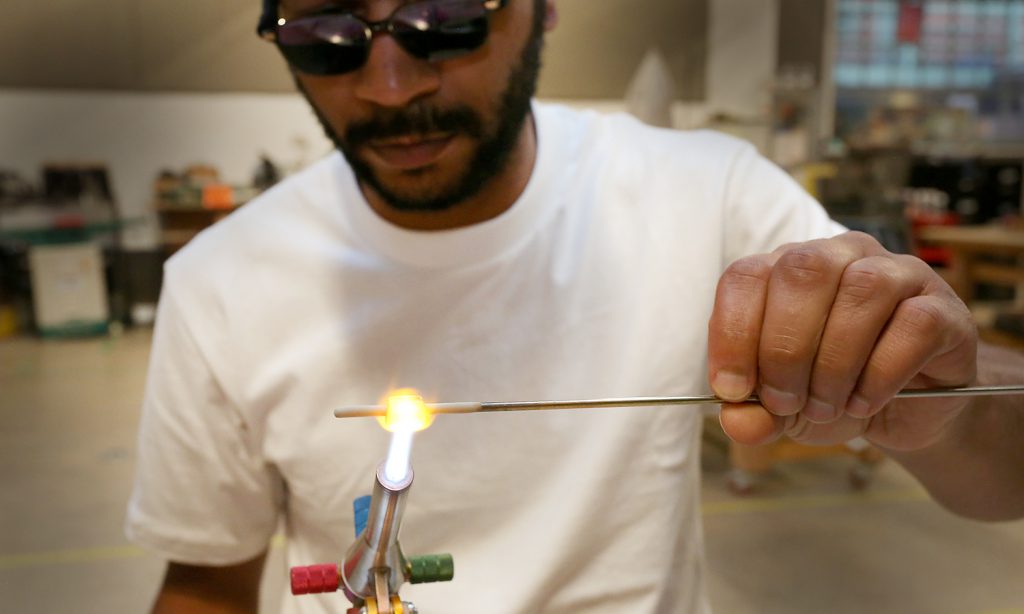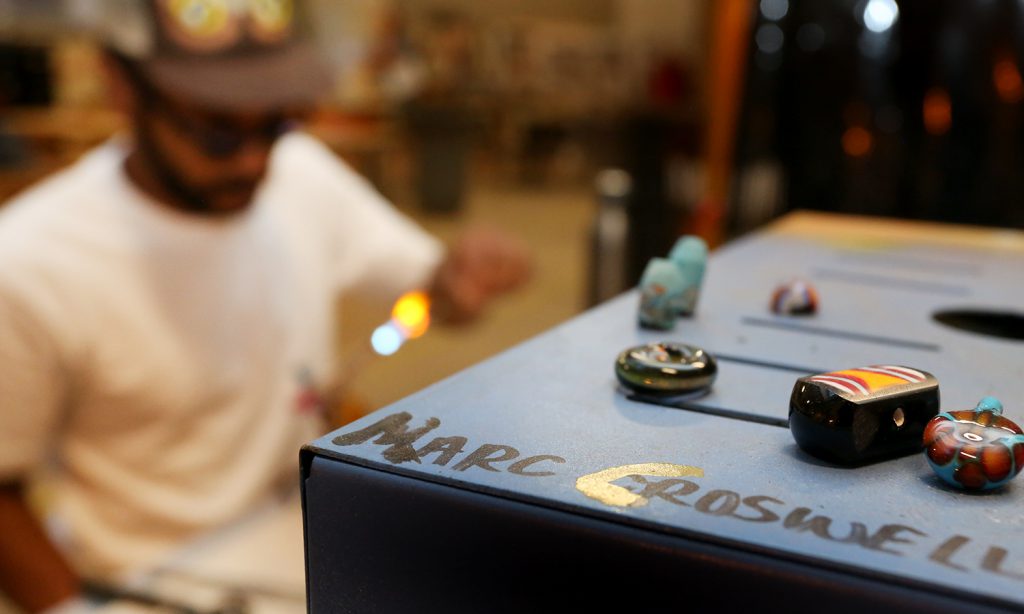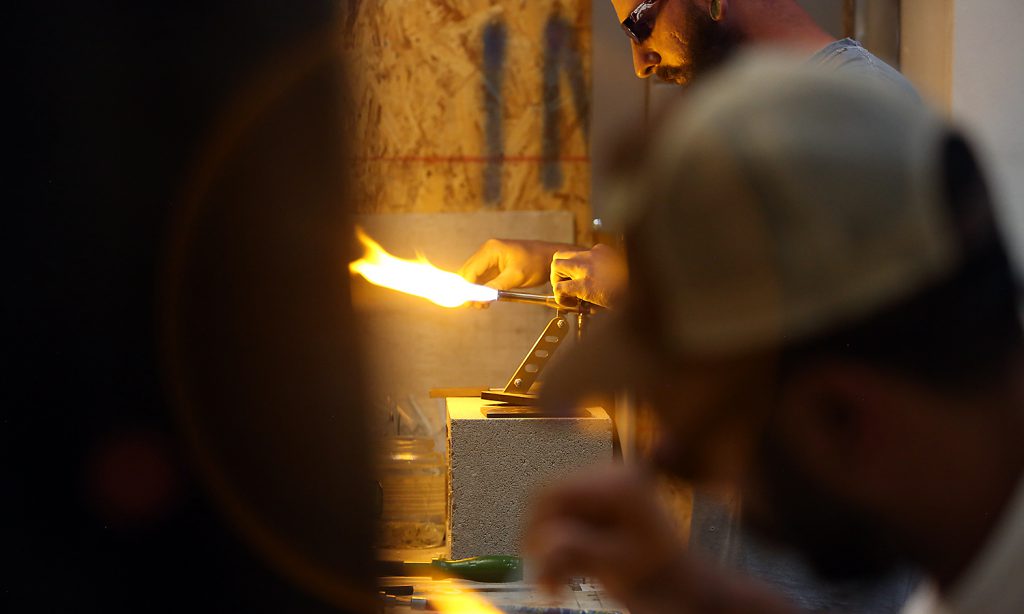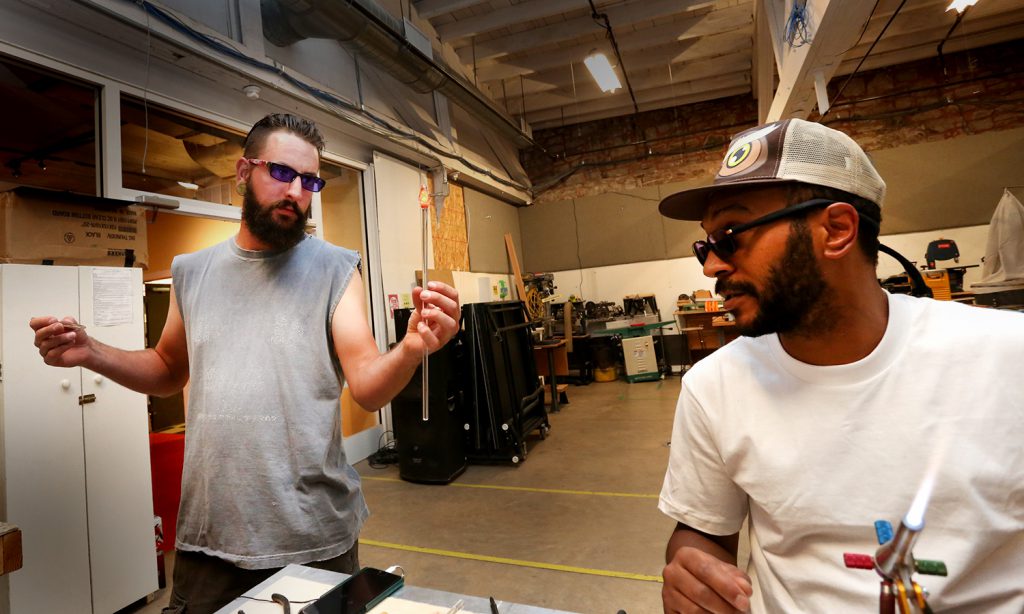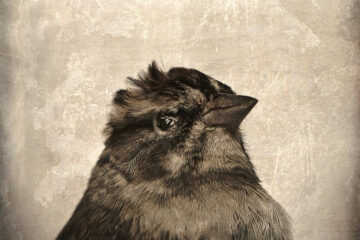There’s 2,000-degree fire lighting up a 10’ by 10’ corner of the Makerspace at the Manitou Art Center. A pair of torches blow heat and possibilities, where straw-like sticks of colored glass morph on command by hand.
This is Manitou Glassworks.
Two lampworkers — Marc Croswell, 42, and Tanner Sauvan, 28 — flow music from one of their smartphones and let their creativity burn.
Like many in Manitou Springs, Marc and Tanner came from elsewhere with stories and craft.
Tanner, what brought you here from Kansas City?
Colorado exists, so I had to be here. (laughs) I have a lot of friends here, up in Denver. So, I used to always visit them. One day I was like, “I don’t know why I don’t just stay.” I went back home, packed up my car and drove here with everything I could fit in it.
I moved to Colorado Springs, initially. I was working as a sign language interpreter and decided that’s not where I wanted to go with my life. At the office, the people who are locals who are from here, they’re like, “Hey, you’re pretty weird, so you should go check out Manitou.”
I walked down — it was five minutes — I was walking past the creek by Soda Springs Park and I was like, “I have to live here.” I didn’t talk to anybody. I was just walking by myself and … “Yeah, this is it.’’
Marc, you moved to Manitou from Cincinnati this summer to be with your girlfriend, Kelly. Were you doing glasswork in Cincinnati?
I was a paper cutter for a board game manufacturer. We did all the -opoly games, like every major college, like Duke-opoly, UVA-opoly — and Dog-opoly, every major dog breed. Every city, Denver-opoly. I cut everything for those people.
I wasn’t doing any glasswork (at the time I moved), because my equipment had gotten stolen. My house got ripped off. It took me a long time to get new equipment and even to find a location to do it. Moving out here, I finally have a spot again. I haven’t blown glass in years, like seven-plus years, just because of the robbery.
I taught classes, though, before and after the robbery. I taught two-day workshops at the Glass Axis in Columbus.
But you lived in Cincinnati. How far was that?
Like, two hours. I’d take a Greyhound — I’d take all my equipment on the bus — and then walk, because I didn’t have money for a cab. I did that on weekends for two and a half years.
Tanner, you work as a sign language interpreter?
I don’t do it anymore. That’s what got me out here financially to be stable, but I found other avenues to make money since, which has been much more enjoyable.
I’m a landscaper now. Big change, but I enjoy it a lot. Mentally it’s much less stressful. Sign language interpreting is very difficult. I was super stressed all the time.
What I did was video relay service, so when somebody calls you over the telephone and a deaf person uses a sign language interpreter like myself, we see each other over a TV monitor and I have a headset, which makes my hands freely accessible, and it’s like having an interpreter in the room with you but it’s over the phone.
It’s very intense because I could go from telling someone that they have this crazy ailment, that they are sick or dying, or speak the last words to their family member. Sometimes it’s very, very emotional stuff.
But that’s just one specific form of interpreting, that’s not interpreting across the board. I did that for a while. I was working at the Colorado School for the Deaf and Blind here last year and that was a lot of fun, doing the sports and stuff for them.
How did you get started in glasswork?
I walked into a fine China shop one day and it was like, “Oh, it would be cool to make these really cool bowls, plates, goblets, cups, things like that.”
I just got some crappy glass from Hobby Lobby and started in my parents’ garage and started playing with it, and then bought better and newer equipment, and started watching videos and trying to figure out more stuff.
I don’t do as much soft glass, like what Marc’s doing with the beads. I’ve been focusing primarily on cremation marbles and pendants, and things with ashes in it, people’s loved ones — dogs, cats. I do marbles, pendants, pipes.
I wouldn’t say sticking to one thing is even my forte. I just kind of dabble, trying to make stuff to the best of my ability.
Marc, you went to the Eugene Glass School. Is that what took you to Oregon?
No, no, no. I just wound up in Oregon. I was traveling the United States and got to Oregon with a dollar to my name. I was like a week from leaving and I got this job at a glass shop that sold all the raw materials for glassblowers, and I met a lot of glassblowers.
My boss, for me to better help customers, started sending me to school for it. I got paid to take classes.
Sounds like a pivotal life thing.
Uh-huh. David Winship was the guy, Winship Designs. Awesome, awesome boss. I thank him for a lot, definitely. I got a friendship for it (nodding at Tanner), besides our working in glass. In the end, I’m right here, I’m right where I’m supposed to be.
Glassblowing is an elitist sport. You have to have the money to invest in all your equipment. For me, if I’d have stayed in Cincinnati, when was I ever thinking about learning how to blow glass? I just happened to get that job.
You didn’t know how to work with glass at all before that?
Nope. I had no idea how glass was built. He got me into a beadmaking class. Then I had, like, 10 classes after that.
Beadmaking is what you’re doing now. You post a lot of it on the Manitou Glassworks Instagram page.
Yeah, they’re the easiest to make and until we revamp the shop I’m going to stick with beadmaking. Once our shop expands, we’ll be able to do a lot more stuff.
Before my hiatus, I was making marbles, pipes, paperweights, pendants, letter openers, saki sushi sets, knife hitters, goblets, candy dishes.
It’s beadmaking for now to get my skills back up, get my hands after being off the torch for so long. Then we’ll start doing bigger stuff together.
Why glass? What is it you guys like about glass instead of, say, painting or something else?
Marc: I think part of it is the longevity of it. It’s like a thousand years and gold and silver will tarnish. You could pick up glass, wipe it off and it’s still right there, still the same thing.
Also, you can take that glass, heat it up and change it into something else. That’s pretty sweet, too. It’s an amorphous solid. It comes in a stick. You can turn it into a ball, and you can turn it back into a stick, if you want to. And you’re doing that with 2,000-degree flame.
I admire painting and the alchemy of photography, like darkroom photography, and metallurgy — if I was going to do something else, it would probably be welding.
Working with fire and working in a 2,000-degree atmosphere, there’s something to be said about that.
And you’re part of a bloodline, a knowledge bloodline. This is passed down. The first beads, Egyptian beads, seed beads, chevron beads. It expanded to Italy and Germany, and spread across Europe. And now that knowledge is passed on to us two (bleeps) at the Manitou Art Center. (both laugh)
It’s crazy how we got here.
Tanner: It’s cool, not having known that until I started to do it, everybody I associated with before had something really cool about them, like they were really good at singing or playing an instrument or something like that, and it’s like, “Well, I want to be good at something, too. At least, give it my best shot.”
By no means do I shine like people who are famous for their glasswork, but it’s having one of those things in your pocket. I set out to do this and it’s very difficult, and that knowledge isn’t free. As much as someone comes in and teaches you, you have to put in the hours to master what it is that you’re doing.
Some of the stuff we’ve seen from when I first got into glass til now, everything is blown up. What people are doing is they’re blowing minds. I think it’s cool and now I have to work my way up there to accomplish something.
What kind of stuff blows your mind?
Tanner: This sounds really weird to somebody that doesn’t know … putting together hollow tubes and sealing together chunks of glass. And that can’t be done when the glass is cold. The entire thing has to be hot. People are coming up with new designs and colors. People are pioneering stuff.
Marc: The American folk glass movement and the American art glass movement in the last 17 years has been led by the pipemakers, because there’s never been such a concentration of any industry where you have product development analyzed at the rate those guys and gals made pipes.
Like, they have to have the color a certain way or it cracks and they don’t get to pay rent, because the 400 pipes they made are all shattered. The feedback the glass color companies get is real time.
Like what Tanner is saying, these kids are coming up with museum-worthy art, but the taboo of it is —
Tanner: But you can smoke it.
Marc: Yeah. It’s total functional art. You can’t do that with a Renoir. You can’t do that with anything, but these guys are putting four-foot sculptures together using teams, and coming up with anything you’ll see in any gallery around the world.
Tanner: That’s that knowledge he was mentioning before. That doesn’t just happen overnight. Someone had to have not only pioneered it but you be fortunate enough to know them or have paid them a great sum of money.
They now make their career off having this knowledge to themselves, and not a lot of people either can do it or know how to do it. So, they have this product that is, at least for awhile, so rare, so genuine, the only thing like it.
Marc, what is it about that bloodline?
The glassblowers of Murano (Italy) were there because they kept burning down the cities on the mainland with their crucibles. And then they were only making stuff for royalty or the church, and they weren’t allowed to leave.
They wanted to keep that secret on the island. If a glassblower escaped, their family would be threatened. So, that knowledge has always been closely guarded — or you’re going to pay for it.
I need to make money, but I also want to make this knowledge readily available to the youth, more than anything. Most of my students have been older women who just wanted to learn how to make beads during retirement.
I’d like to open up a school for kids. The masters of Italy, they started when they were seven in their dad’s shop. There’s no reason why we can’t do that here.
Tanner, is there something you’ve learned or gained in your life from your glasswork?
Patience. (laughs) Patience.
I just decided I was going to do it, successfully or if I failed at it. I thought I might enjoy doing it and, come to find out, I do.
I get that. I joined the Makerspace recently to try out some things and see what sparks some skills and interests for me, like welding.
Marc: There are so many things here under one roof. There’s a photography dark room upstairs.
Tanner: 3-D printer.
Marc: Laser cutter.
Tanner: A leatherworking shop. Yarn galore over there.
Marc: How much is that laser cutter? We’d have to have a security badge to get through a door to use that somewhere else, and now we have one just right over there.
Tanner: Yeah. That’s one of the best things about this place. He just got here and hooked up with me, or vice versa. Look at the community and what all it has to offer you. We’re doing this to have fun and find great people, just to be happy and find happiness, you know?
 This Humanitou conversation is cross-posted at PeakRadar.com. | PeakRadar.com is the Pikes Peak region’s cultural calendar and digital cultural center, connecting residents and tourists with our vibrant arts community. Your source for what’s happening is PeakRadar.com!
This Humanitou conversation is cross-posted at PeakRadar.com. | PeakRadar.com is the Pikes Peak region’s cultural calendar and digital cultural center, connecting residents and tourists with our vibrant arts community. Your source for what’s happening is PeakRadar.com!
